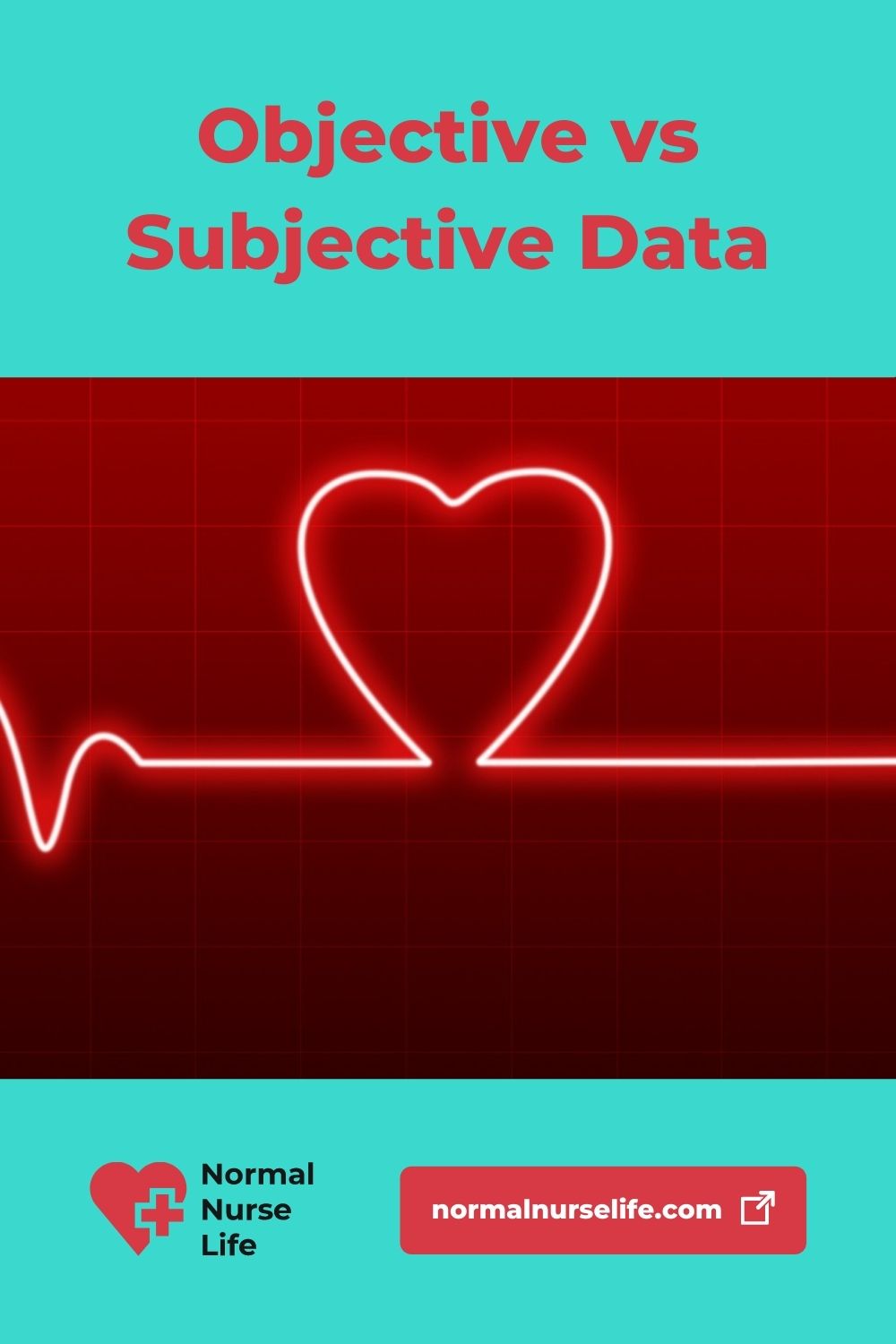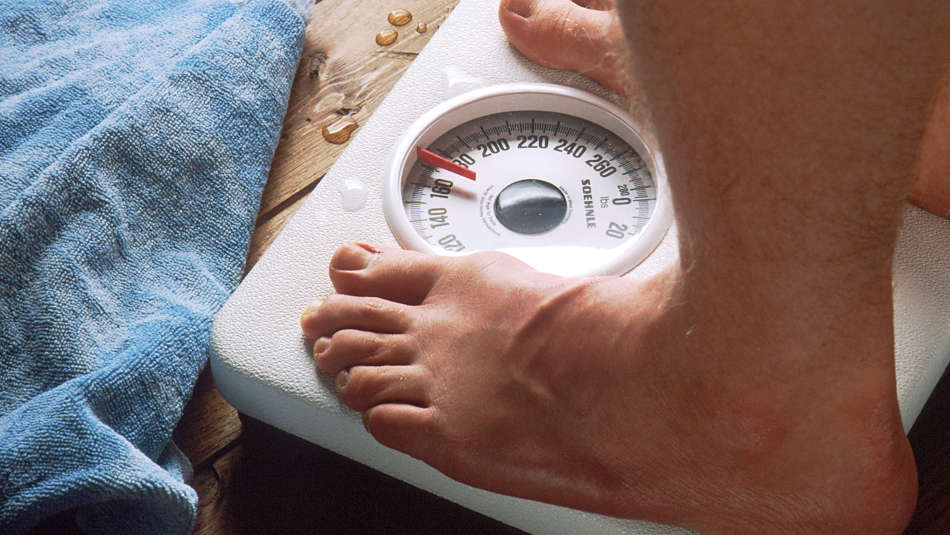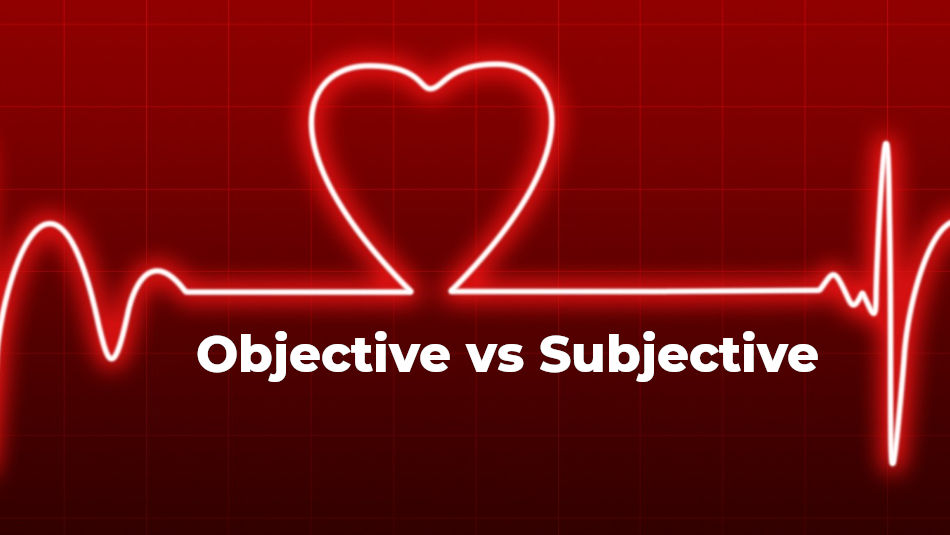When we look at finer points of nursing and patient care, there are scores of scientific and medical terms that are considered very important and indispensable.
They are considered critical and extremely vital for taking note of the overall condition of the patient and then offering the right treatment accordingly.
Healthcare professionals often have to come across a lot of vitals, numbers, lab values, and test results.
These reports are considered important because they help the doctors and healthcare providers to diagnose the diseases or medical conditions and start treatment accordingly.
However, we need to understand that the data or information that doctors have to deal with may not always be a numerical value.
There could be many subjective data that also could be crucial in giving the right treatment to the patients.
Hence, understanding the differences between objective vs subjective data is important for the medical fraternity and also for addressing diseases and medical conditions that the patients may be suffering from.
In this article, we will understand the basics of objective data and subjective data and have a look at some real-life examples so that the readers can have a better understanding of the same.
We hope that the information that is being shared over the next few lines could be useful not only for the readers but also for those who are attached to the medical profession.
Before we can compare these two types of data we should know what is objective data and what is subjective data.
So let’s get going.
If you rather prefer to learn via video format, check out this objective vs subjective data video by Christina Rafano.
If you prefer reading, keep on reading to learn more about objective vs subjective data, their differences and to get examples of them.
Pin me on Pinterest!

Table of Contents
What is objective data?
We will first get started by trying and having a reasonably fair understanding of the question as to what is objective data.
From a layman’s perspective, objective data in nursing parlance is about the collection of data and information through observations.
These include the various senses such as hearing, seeing, smelling and touching.
These are considered to be useful when it comes to gathering critical and basic information about the patients.
The behavior of the patient, test results, actions, physical examination, and measurements are also considered to be a part of such objective data.
We need to understand that the process of obtaining objective data as and when the patients start interacting with the nurses and primary health care providers.
There are quite a few activities and information that could fall under objective data.
These might include noticing specific behaviors of the patient, reading the body language of the patient, and much more.
The nursing fraternity also tries and understands the kind of eye contact the patient exhibits, hand gestures, body positions that he or she makes amongst other things.
These are often referred to as the first information that should be collected.
Sometimes shyness could also lead to a lack of shyness.

If a patient is suffering from stomachache he or she might feel comfortable lying in a fetal position.
Nervousness is often indicated when the patient keeps rubbing the hands continuously.
These are general observations and many times these data and information alone may not be enough to lead to conclusive information about the patient.
So it’s time to move on to what is subjective data and how it’s used.
Before you understand both it’s impossible to give you a proper objective vs subjective data comparison.
What is subjective data?
If you are suffering from a health condition or if you had suffered from it, you certainly would have exhibited some common symptom.
For example, if it was a common cold or flu, you may have had a runny nose, body child, and cough.
When you visit a doctor or a nurse these medical professionals may ask you these types of questions.
Related articles to this subject:
It is quite possible that you may not understand the importance of answering properly and correctly to these questions.
You should try and answer the question honestly, fully and as coherently as you can.
This will help the doctor and the nursing staff to know your condition, help in better diagnosis and treatment.
If you want the right answer to the question as to what is subjective data, you must put a few things in perspective.
Put in simple words, subjective data is trying and collecting information through communication.
When a patient visits a doctor or registered nurse, he or she is asked the reason for visiting the doctor.
The replies coming from the patients are classified as subjective data.
Patients often talk about physical symptoms and share information as to how they are feeling when they are unwell.
This could discomfort, pain, burning, itching, or other types of abnormal sensations.
They also talk about the problems that they are experienced as far as their bodies are concerned.
These might include muscle spasms, vomiting, and coughing.
See also: Nursing Care Plan for Infection
In some cases, patients may also have a few more things to say about their attitudes, beliefs, and perception of various things that are happening inside their minds, bodies, and also outside of them.
They may often believe that they are suffering from a particular illness because they had it before or they may have researched for the symptoms on the internet.

Some other patients might believe that they are fine and healthy and are visiting the doctors or nurses for a routine medical check-up.
Patients may bring up dozens of such issues, and nurses and doctors should realize that it is important to listen to what they are saying.
This will help nurses to gather the right type and kind of subjective data.
Many health care workers are known to use specific techniques and tools for gathering the right types of objective data.
They may use devices such as a stethoscope to monitor the breathing of the lungs and also the heartbeat.
Thermometers may be used to read body temperature and they also may use blood pressure monitoring machines to monitor blood pressure.
We all know that blood pressure is a vital sign for any patient and this forms an important part of subjective data.
Now that you know what is objective and subjective data it’s time to compare the differences between them.
Difference between objective and subjective data
This is a true comparison on objective vs subjective data.
As mentioned above, objective data is gathered by observing the patients by understanding more about their hearing, smelling, seeing, and touching.
Nurses and doctors also try and understand more about patient behaviors, actions and also from information that is gathered from physical examination and test measurements.
At times there could be a thin line separating objective and subjective data and it could also belong to both the above categories.
Let us have a look at some factors that may help you understand the difference between objective and subjective data.
Underlying basis
Objective vs subjective data differences on an underlying basis? Let’s find out.
When we refer to subjective data, the personal interpretation of the patient is the basis for gathering information.
Whatever the patient conveys through the interaction with the doctor/nurse is considered to be subjective data in nature.
On the other hand, objective data has a different underlying base.
It is done through observing the patient and the results and facts are often simple and straightforward.
Tests/experiments and results fall under the category of objective data.
Decision making
Doctors may not find subjective data completely reliable for making the decision and prescribing treatment and medications.
Related article: Can a Nurse Practitioner Prescribe Medication?
This is because the data is based on whatever the customers feel or say and it has to be assumed that he or she is being correct and factual about it.
However, objective data is more reliable and it is derived based on information that has been observed and gathered through other facts.
These include tests/experiments and analysis.
Hence, objective data is more factual, reliable, and measurable and therefore it can be trusted for recommending further analysis or even prescribing medicine or other such courses of action.
Common areas
What are objective vs subjective data differences in common areas? Here’s the answer for you.
Analysis and subjective data can generally be found on internet chat, biographies, forums, personal blogs, editorials, etc.
On the other hand, objective data is the basis for reporting information.
The data and information that is collected are done through many efficient ways and methods.
It is considered reliable because of some proven, time-tested and accurate procedures are followed.
It is considered to be very dependable and reporting such data is considered appropriate and crucial.
Now that you know the difference between objective vs subjective data it’s time to move on to subjective and objective data examples.
Subjective and objective data examples
The list of subjective data is quite a bit and it may not be possible to have a look at all of them.
However, there are some common examples that are quite common and it happens almost every time there is an interaction between the patients or the doctors/nurses.
Examples of subjective data

- Dizziness
- Pain
- Shortness of breath
- Itching
- Exhaustion
- Vomiting
- Cough
- Runny nose
How about the objective data examples?
Examples of objective data

The objective is more dependable because they are backed by facts, figures, and numbers.
The list of objective data again is quite big and we are mentioning a few of them for the benefit of our readers:
- Height
- Weight
- General appearance
- Blood pressure
- Heart rate
- Levels of consciousness.
As you can see, these objective data examples can be measured.
Conclusion: Objective vs subjective data
There is no denying the fact that both objective, as well as subjective data, has its own importance and criticalities.
Subjective data is perhaps a first-hand attempt by nurses and doctors to know more about the patient based on the observations that are made on him or her.
On the other hand, objective data could be more conclusive because it is backed by reports, medical tests, x-rays, scan reports, MRI, ECG, blood tests, and other such things.
When the patient first visits the nurses, primary healthcare providers or specialists, they also conduct some routine checks.
These include blood pressure reading, pulse reading, temperature reading, etc and these also fall under the category of objective data.
A combination of both subjective and objective data helps the doctors to have an overall idea about the condition and possible illness or medical condition.
This will help them to diagnose and then adopt the right line of treatment and medication.
Now you should know all about the objective vs subjective data.
If you’d like to learn some more nursing-related check out these articles of ours:
- Nursing Care Plan for Constipation
- What Does PRN Mean?
- What Does ETOH Mean?
- Does Birth Control Pills Make You Gain Weight?
I’d really appreciate if you could give this article a star rating; it only takes a couple of seconds.
